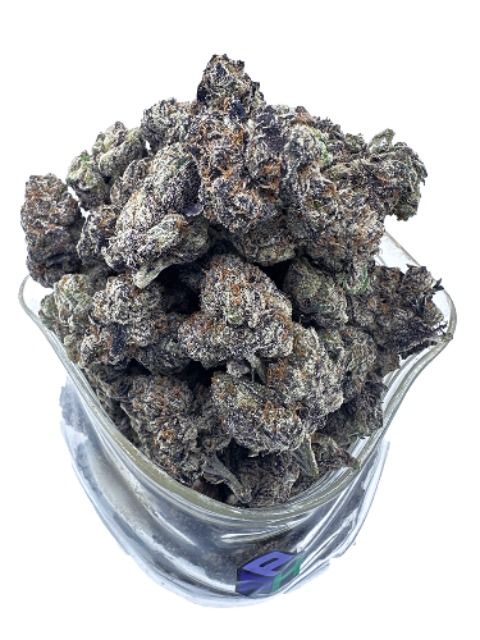Description
Blackberry Caviar Key Takeaways
Blackberry Caviar is an indica-forward hybrid that delivers a deeply relaxing body high wrapped in a luxurious flavor profile of berry jam and citrus gas.
THC levels typically hover around 26%, making it potent and best suited for evening or wind-down sessions.
Dominant flavor and aroma notes include blackberry jam, sweet grape, and a bright citrus-diesel finish.
Commonly used for relaxation, stress relief, sleep support, and mood elevation thanks to its calming, non-stimulating nature.
Performs well under experienced cultivation, with a flowering time typical of its lineage and medium yields.
Genetic Lineage
Blackberry Caviar is the product of Grape Gas × Lantz, a pairing that combines sweet, jammy fruit with balanced gas and resin-rich density.
-
Grape Gas contributes deep fruit complexity and a smooth, gassy backbone.
-
Lantz adds potency, vibrant coloration, and resin production.
This cross was selectively bred to emphasize dessert-like flavor, bag appeal, and a luxurious smoking experience.
THC/CBD Content
-
THC: ~26%
-
CBD: Low (<1%)
The high THC level makes it powerfully relaxing while the low CBD keeps the psychoactive edge fully intact.
Terpene Profile
| Terpene | Aroma / Flavor Notes | Effects |
|---|---|---|
| Myrcene | Earthy, herbal | Sedative, relaxing |
| Caryophyllene | Spicy, peppery | Anti-inflammatory, calming |
| Limonene | Citrus, lemon candy | Uplifting, mood-brightening |
These terpenes combine to create a profile that’s rich, fruity, and gassy while delivering strong body ease.
Effects
-
Heavy Body Relaxation: Deep physical calm that’s ideal for winding down.
-
Mental Ease: Quiet, tranquil headspace without mental fog.
-
Mood Comfort: Smooth euphoria with no racing thoughts.
-
Sleep Induction: In higher doses, it can lull you into restful sleep.
Medical Uses
Blackberry Caviar’s effects make it a favorite for:
-
Stress & Anxiety Relief – Calms the mind without overstimulation.
-
Insomnia – Encourages restful, sustained sleep.
-
Muscle Tension & Aches – Relieves soreness and physical discomfort.
-
Mood Elevation – Comforting flavor paired with calming euphoria.
Flavor and Aroma
-
Aroma: Tart blackberry jam, ripe grape, and sweet citrus gas.
-
Flavor: Dessert-like blackberry cobbler with purple sweet-tart gas notes.
-
Aftertaste: Lingering sweet berry with a touch of fuel funk.
Appearance
-
Coloration: Deep purples and blacks with hints of dark green, accented by bright orange pistils.
-
Trichome Density: Extremely frosty, with a heavy resin coat.
-
Bud Structure: Dense, chunky nugs with a sticky break-down.
Grow Information
-
Flowering Time: Estimated 8–9 weeks.
-
Yield: Medium, with premium bag appeal and resin output.
-
Climate Needs: Prefers consistent temps and moderate humidity.
-
Difficulty: Best for intermediate to advanced growers who want boutique-level results.
Adverse Effects
| Adverse Effect | Description |
|---|---|
| Dry Mouth | Common—stay hydrated |
| Dry Eyes | Manage with drops |
| Sedation | Strong in high doses; evening use recommended |
| Couch-Lock | Possible if overconsumed |
Comparisons with Similar Strains
| Strain | Similarities | Differences |
|---|---|---|
| Blueberry Caviar | Same lineage, fruit-forward profile | Blueberry Caviar is more uplifting and sativa-leaning |
| Blackberry Kush | Sedative berry indica | Blackberry Caviar is more complex with citrus gas |
| Grape Gas | Fruity-gas hybrid | Blackberry Caviar has deeper berry jam sweetness |
History and Origin
Released as part of a boutique “Caviar Collection” from elite breeders, Blackberry Caviar was created to blend luxury flavor, striking bag appeal, and full-body relaxation. The cross of Grape Gas × Lantz produces a strain that’s as visually stunning as it is indulgent to smoke, quickly gaining a reputation as a top-shelf indica hybrid.
Frequently Asked Questions
Is Blackberry Caviar indica or sativa?
Indica-dominant hybrid, leaning heavily toward body relaxation.
Does Blackberry Caviar make you sleepy?
Yes—especially in higher doses, it’s highly sedative.
What does it taste like?
Blackberry cobbler, grape jam, and citrus gas.
Is Blackberry Caviar beginner-friendly?
Only in small doses—its high THC content can be overwhelming.
When is the best time to use it?
Evening or nighttime for relaxation, recovery, or before bed.
Additional information
| Donation Amount | 1/8, 1/4, 1/2, 1oz |
|---|
Reviews (0)
Be the first to review “Blackberry Caviar” Cancel reply
You must be logged in to post a review.
This site uses Akismet to reduce spam. Learn how your comment data is processed.
Related products
EXOTICS
EXOTICS
EXOTICS
EXOTICS
EXOTICS










Reviews
There are no reviews yet.